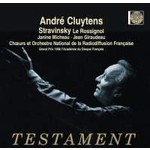
Le Rossignol (complete opera) (with Delage: Quatre poems hindous; Berceuse phoque)
 $38.00
Out of Stock
$38.00
Out of Stock6+ weeks add to cart
STRAVINSKY
Le Rossignol (complete opera) (with Delage: Quatre poems hindous; Berceuse phoque)
Janine Micheau, Genevieve Moizan, Jean Giraudeau, Lucien Lovano / Chorus and Orch. of the French Nat. Radio, Andre Cluytens
[ Testament / CD ]
Release Date: Sunday 15 March 2015
This item is currently out of stock. It may take 6 or more weeks to obtain from when you place your order as this is a specialist product.
"Igor Stravinsky conceived his lyric opera in three acts, Le Rossignol, after a tale by Hans Christian Andersen, the first performance presented by Diaghilev's Ballet Russes in Paris, on 26 May 1914.
The score captures both the poetry and irony of Andersen's tone. It has a touch of lyrical warmth and tender melancholy in it-not typically "Stravinskian," but obviously inspired by Andersen. The musical style gravitates toward Petrushka, with the frequent use of ostinati, sudden dynamic shifts, preference for short melodic segments, erratic rhythms, and theatrical "signals" and "gestures." We find in the opening deliberate influences from Impressionism, particularly from Debussy's Nuages and the more pointillistic and exotic aspects of Ravel. The fairy-tale elements concede to the potent influence of Stravinsky's teacher, Nikolai Rimsky-Korsakov. A quotation from Mussorgsky's Sunless cycle also infiltrates the opening pages. Ironically, while Stravinsky criticized his limits as an opera composer, claiming the ballet medium better suited him, Le Rossignol became a ballet in 1917 with choreography by Massine, and the orchestra led by Ernest Ansermet.
At the same time, the score looks toward Stravinsky's neo-Classical style of the 1920s, when the large symphonic orchestra would be rejected in favor of smaller ensembles, and the winds, percussion and piano with their clear articulation would replace more expressive strings. In the composer's own words, in the Song of the Nightingale he "treated [the orchestra] more as a chamber orchestra and laid stress on the concertante side, not only of the various solo instruments, but also gave this role to whole groups of instruments. This orchestral treatment was well adapted to music full of cadenzas, vocalises, and melismata of all kinds…" Stravinsky's concept incorporates brief tableaux, often in timbre or dynamic contrast to each of other, with short, curt phrase offset by extended melismas, as in the Act II Chanson de rossignol, which well taxes Janine Micheau's vocal stamina. The a cappella vocal writing for male voices often anticipates passages in Carl Orff, and a jazzy moment or two adumbrate Gershwin.
The poem follows the narrative. It opens with a picture of the Chinese Emperor's Court with its lavish décor and noisy bustle. The next episode brings the first sharp contrast: a small bird, invited by ministers to please their emperor, sings its gentle, touching song (flute cadenza, then a violin's melody, accompanied by piano, harp, and celesta). Suddenly there is another nightingale-a gilded and sparkling mechanical gift from the Emperor of Japan. It repeats the same primitive tune over and over again (piccolo, flute, oboe), but the court is charmed. The real bird, saddened, flies away to the forest and to a fisherman, and so the angry Emperor names the mechanical one the First Singer of the Imperial Court. But when Death arrives to take the Emperor (dark timbres and slow tempo), the real bird returns and saves the ailing Emperor with the beauty of its song. However, it rejects the invitation to stay forever: the bird wants the freedom to sing for anyone in need. The melancholic song of a fisherman concludes the poem.
Many thanks to the indefatigable Andre Cluytens (1905-1967) for his efforts between March and April of 1955 to bring poise and vocal resonance to this knotty and stylistically eclectic score by Stravinsky. The music of Maurice Delage (1879-1961), a long-time admirer of Debussy, especially his Pelleas et Melisande, attempts to convey his fondness for India and the work of Rudyard Kipling. The two scores of 1912 may remind some film buffs of the "exotic soiree" music in Albert Lewin's version of The Picture of Dorian Gray, music both filmy and slick. The recording (7 June 1951) has been suavely remastered by engineer Paul Baily" (AudAud.com)